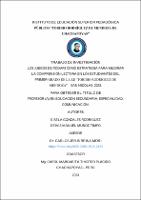| dc.contributor.advisor | Dr. Carlos Jesús Reina Mori | es_PE |
| dc.contributor.author | Gonzales Rodriguez, Gisela | es_PE |
| dc.contributor.author | Muñoz Timpo, Deivis Manuel | es_PE |
| dc.date.accessioned | 2025-08-07T16:54:04Z | |
| dc.date.available | 2025-08-07T16:54:04Z | |
| dc.date.issued | 2023-12-27 | |
| dc.identifier.uri | http://hdl.handle.net/123456789/74 | |
| dc.description.abstract | The following research project titledRodari´s games asstrategy to improve the
Reading comprehension in students of first grade in “Toribio Rodriguez de Mendoza
high school”, San Nicolas – 2023, aimed to determine the Rodari´s games influence
in Reading comprehension in students of first grade in “Toribio Rodriguez de
Mendoza”, San Nicolas. this research Project is quantitative – applied with a preexperimental design.
The research is formed by two variables, Rodari´s games and reading
comprehension. The population consisted by 403 students, where 31 students were the
sample.
To determine the level of Reading comprehension in the students of first grade
we worked with literal, inferential, and critical, we took a pre-experimental test where
we can see that a lot of students were in a low level, with a 61.3% in a beginning level,
32% in a ´processlevel and 6,5 in an achieved level and a 35% in an outstanding level.
Finally, we ca say thatRoldani´s games have improved in a significant way the reading
comprehension in students in Toribio Rodriguez de Mendoza high school”. | es_PE |
| dc.description.tableofcontents | PÁGINA DE JURADOS Y ACESOR.....................................................................ii
RESUMEN........................................................................................................ iii
ABSTRACT ...................................................................................................... iv
DEDICATORIA..................................................................................................v
AGRADECIMIENTO ....................................................................................... vi
INTRODUCCIÓN...............................................................................................1
CAPÍTULO I.......................................................................................................2
1.0. PLANTEAMIENTO DEL PROBLEMA .............................................3
1.1. Formulación del problema ................................................................3
1.2. Formulación del problema. ...............................................................5
1.2.1. Problema general................................................................................5
1.2.2. Problemas específicos….....................................................................5
1.3. Objetivos de la investigación.............................................................5
1.3.1. Objetivo general .................................................................................5
1.3.2. Objetivos específicos… ................................................................................5
1.4. Formulación de hipótesis ..................................................................6
1.4.1. Hipótesis general. ..........................................................................6
1.4.2. Hipótesis específica ............................................................................6
1.5. Justificación de la investigación........................................................7
1.5.1. Teórica................................................................................................7
1.5.2. Metodológica….................................................................................7
1.5.3. Práctica… ..........................................................................................7
CAPÍTULO II......................................................................................................9
2.0. MARCO TEÓRICO..............................................................................9
2.1. Antecedentes de la investigación.......................................................9
2.1.1. Internacionales....................................................................................9
2..1.2. Nacionales ......................................................................................10
2.2.3. Regionales .......................................................................................11
2.2. Bases teóricas. .................................................................................12
2.2.1. Juegos de Rodari...............................................................................12
2.2.1.1 Vamos a confundir cuentos… .........................................................13
2.2.1.2. Las fábulas al revés…....................................................................14
2.2.1.3. Lo que pasa después… ..................................................................14
2.2.1.4. Importancia de los juegos…..........................................................15
2.2.1.5. Teorías del constructivismo….......................................................16
2.2.1.6. Teoría del trabajo-juego de Freinet… ...........................................16
2.2.2. Comprensión lectora....................................................................16
2.2.2.1. Importancia de la comprensión lectora .........................................16
2.2.2.2. Niveles de la comprensión lectora….............................................17
2.2.2.3. Nivel literal....................................................................................17
2.2.2.4. Nivel inferencial… ........................................................................17
2.2.2.5. Nivel crítico…...............................................................................18
2.2.2.6. Objetivos de la comprensión lectora .............................................18
2.2.2.7. Teorías de la comprensión lectora….............................................19
2.3. Definición de términos. ...................................................................19
CAPÍTULO III ..................................................................................................22
3.0. METODOLOGÍA DE LA INVESTIGACIÓN ..................................22
3.1. Identificación de las variables de la investigación ..........................22
3.1.1. Definición conceptual ......................................................................22
3.1.2. Definición operacional......................................................................22
3.2. Tipo, niveles y diseño de investigación...........................................23
3.2.1. Tipo, es de nivel cuantitativo............................................................23
3.2.2. Nivel aplicativo….............................................................................24
3.2.3. Diseño…...........................................................................................24
3.3. Población y muestra. .......................................................................24
3.3.1 Población...........................................................................................24
3.3.2. Muestra….........................................................................................25
3.4. Técnicas e instrumentos de recolección de datos............................26
3.4.1. Técnica..............................................................................................26
3.4.2. Un instrumento de evaluación… ......................................................26
3.5. Procesos de prueba de hipótesis y análisis de datos........................27
3.6. Media...................................................................................................27
3.7. Mediana… ..........................................................................................28
3.8. Moda…...............................................................................................28
3.9. Desviación estándar............................................................................29
CAPÍTULO IV..................................................................................................31
4.0. DESCRIPCIÓN DE LOS ANÁLISIS Y RESULTADOS .................31
4.1. Análisis de la prueba de entrada del grupo experimental (pre test).
.........................................................................................................31
CAPÍTULO V ...................................................................................................46
5.0. DISCUSIÓN, CONCLUSIONES Y RECOMENDACIONES ..........46
5.1. Discusión.........................................................................................46
CONCLUSIÓN ..........................................................................................49
RECOMENDACIONES ............................................................................51
REFERENCIAS BIBLIOGRÁFICAS ..............................................................52
ANEXOS……………………………………………………………………………………………57
ÍNDICE DE TABLAS
Tabla 2: Frecuencia de los puntajes obtenidos en el pre test ………...........................32
Tabla 3: Medidas de tendencia central en el pre test…………………………………...33
Tabla 4: Nivel la comprensión lectora en el pre test y post test……...……………… 35
Tabla 5: Pre test y post test en el nivel inferencial…………………………………...36
Tabla 6: El pre test y post test en el nivel criterial……………………………………38
Tabla 7: Evaluación del post test…………………………………………………….39
Tabla 8: Frecuencia de los puntajes obtenidos en el post test……………………......40
Tabla 9: Medidas de posición y tendencia central…………………………………...42
Tabla 10: Comparación del pre test y post test……………………………………….43 | es_PE |
| dc.format | application/pdf | es_PE |
| dc.language.iso | spa | es_PE |
| dc.relation | LOS JUEGOS DE RODARI COMO ESTRATEGIA PARA MEJORAR LA COMPRENSIÓN LECTORA EN LOS ESTUDIANTES DEL PRIMER GRADO DE LA I.E “TORIBIO RODRÍGUEZ DE MENDOZA” – SAN NICOLAS. 2023. | es_PE |
| dc.relation.uri | Investigación | es_PE |
| dc.rights | info:eu-repo/semantics/openAccess | es_PE |
| dc.subject | Investigación | es_PE |
| dc.title | LOS JUEGOS DE RODARI COMO ESTRATEGIA PARA MEJORAR LA COMPRENSIÓN LECTORA EN LOS ESTUDIANTES DEL PRIMER GRADO DE LA I.E “TORIBIO RODRÍGUEZ DE MENDOZA” – SAN NICOLAS. 2023. | es_PE |
| dc.type | info:eu-repo/semantics/bachelorThesis | es_PE |
| dc.type.version | info:eu-repo/semantics/publishedVersion | es_PE |
| dc.publisher.country | PE | es_PE |
| dc.subject.ocde | https://purl.org/pe-repo/ocde/ford#5.03.00 | es_PE |
| renati.author.dni | 71094424 | |
| renati.author.dni | 73967596 | |
| renati.advisor.orcid | https://orcid.org/0009-0006-8915-2423 | es_PE |
| renati.advisor.dni | 33430014 | |
| renati.type | https://purl.org/pe-repo/renati/type#trabajoDeInvestigacion | es_PE |
| renati.level | https://purl.org/pe-repo/renati/nivel#tituloProfesional | es_PE |
| renati.juror | P: Mg. Fanny Cruz Lopez | es_PE |
| renati.juror | S. Prof. Jhesibel Ramos Vilcarromero | es_PE |
| renati.juror | V. Prof. Leslie Sifuentes Chavez | es_PE |
| thesis.degree.name | Profesor/a de Comunicación | es_PE |
| thesis.degree.grantor | Instituto de Educación Superior Público Pedagógico "Toribio Rodríguez de Mendoza" | es_PE |
| thesis.degree.discipline | Educación Secundaria, Especialidad: Comunicación. | es_PE |



